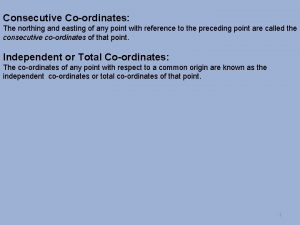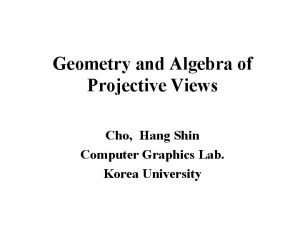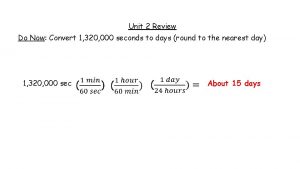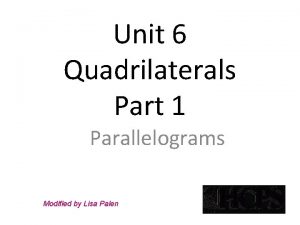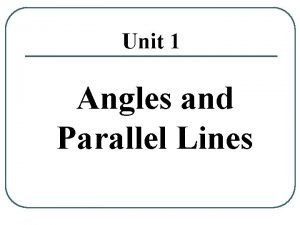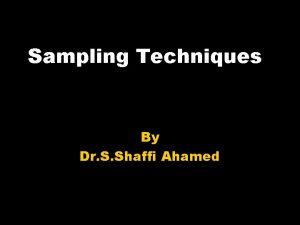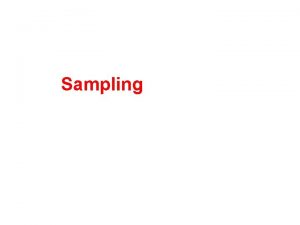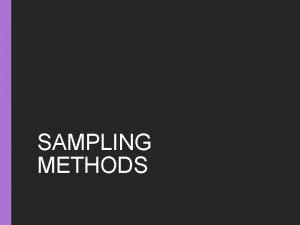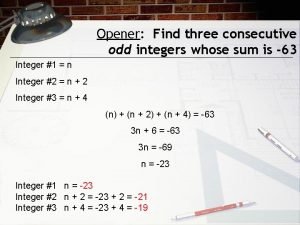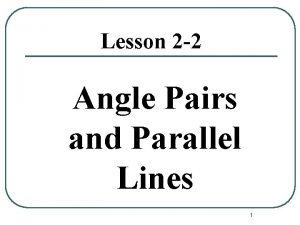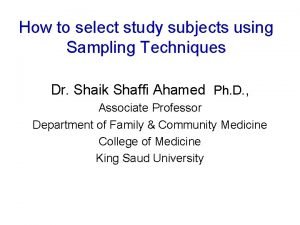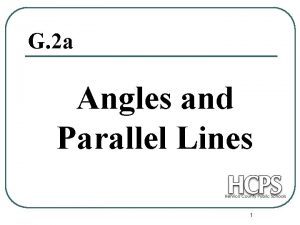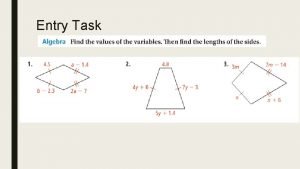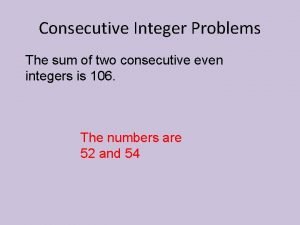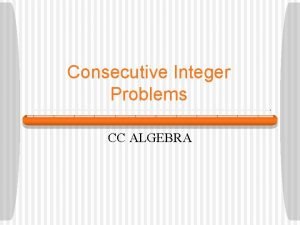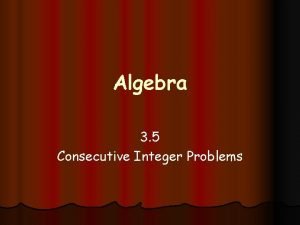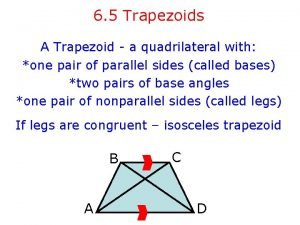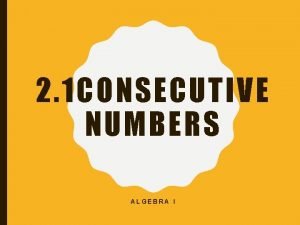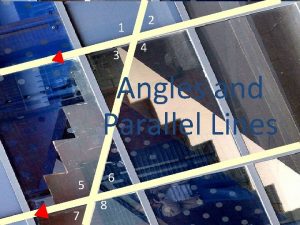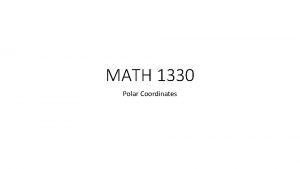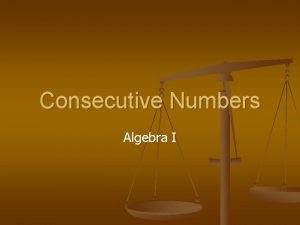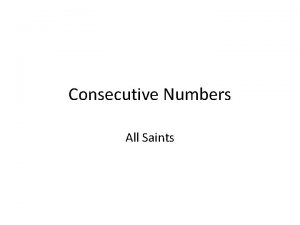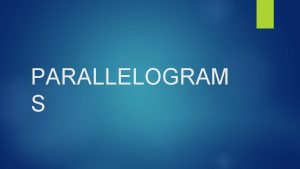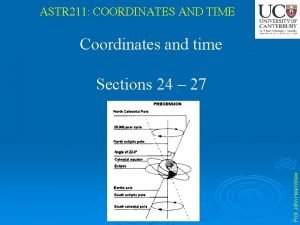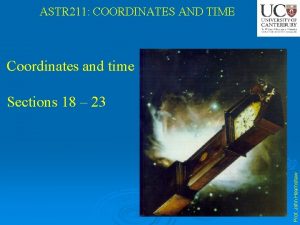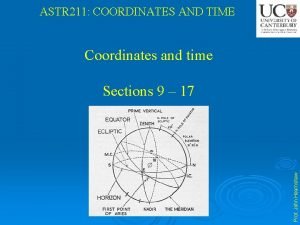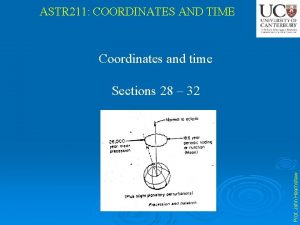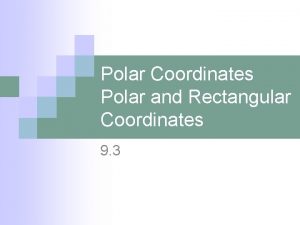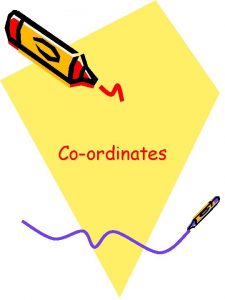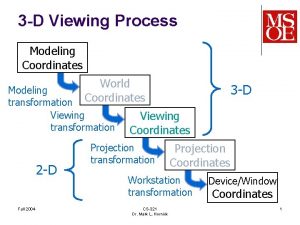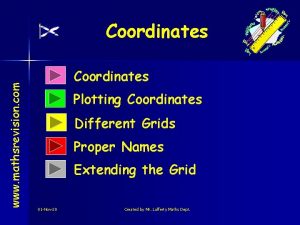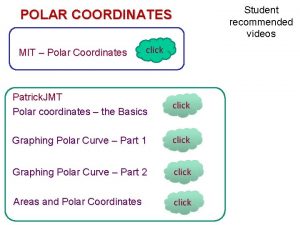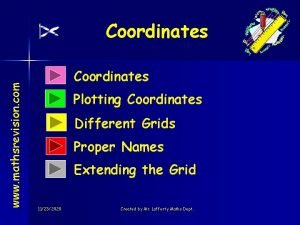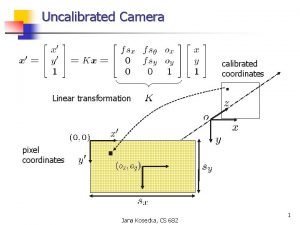Consecutive Coordinates The northing and easting of any






![d. N IJ = [ e. N / SD ] x D IJ Applied d. N IJ = [ e. N / SD ] x D IJ Applied](https://slidetodoc.com/presentation_image/2c44d3dd990ac873addee2ecd4fa3156/image-7.jpg)



![d. E IJ = [ e. E / arithmetical sum of all easting ] d. E IJ = [ e. E / arithmetical sum of all easting ]](https://slidetodoc.com/presentation_image/2c44d3dd990ac873addee2ecd4fa3156/image-11.jpg)

![d. N IJ = [ e. N / arithmetical sum of all northings ] d. N IJ = [ e. N / arithmetical sum of all northings ]](https://slidetodoc.com/presentation_image/2c44d3dd990ac873addee2ecd4fa3156/image-13.jpg)















- Slides: 28

Consecutive Co-ordinates: The northing and easting of any point with reference to the preceding point are called the consecutive co-ordinates of that point. Independent or Total Co-ordinates: The co-ordinates of any point with respect to a common origin are known as the independent co-ordinates or total co-ordinates of that point. 1

Horizontal Control TRAVERSE We have started to compute the traverse station coordinates from an anticlockwise polygon traverse. We tested the sum of the observed angles against the sum of the internal angles of the polygon, and if within an acceptable value we distributed the misclosure. We established the bearings of all the traverse lines and then calculated the changes in Easting and Northing for each line. The algebraic sum of these changes should be ZERO. The values give the error e. E and the error e. N. The linear misclosure e = (e. E 2 + e. N 2) was calculated and used to find the FLM. If acceptable then distribute the errors. By : a) b) Bowditch Method - proportional to line distances Transit Method - proportional to DE and D N values c) Numerous other methods including Least Squares Adjustments

a) Bowditch Method - proportional to line distances This rule, also termed as the compass rule, is used to balance the traverse when the angular and linear measurements are equally precise. The e. E and the e. N have to be distributed For any line IJ the adjustments are d. E IJ and d. N IJ d. E IJ = [ e. E / perimeter of traverse ] x D IJ Applied with the opposite sign to e. E d. N IJ = [ e. N / perimeter of traverse ] x D IJ Applied with the opposite sign to e. N

CO-ORDINATE DIFFERENCES WHOLE HORIZONTAL CIRCLE DISTANCE CALCULATED BEARING D q DE DN 00 00 00 638. 57 306 12 51 1576. 20 -1271. 701 +931. 227 195 54 06 3824. 10 -1047. 754 -3677. 764 47 44 33 3133. 72 9172. 59 3 +2319. 361 +2107. 313 3 0. 000 +638. 570 -0. 094 e. E e = (e. E 2 + e. N 2) = (0. 0942 + 0. 6542) = 0. 661 m Fractional Linear Misclosure (FLM) = 1 in SD / e = 1 in 9172. 59 / 0. 661 = 1 in 13500 Check 2 -0. 654 e. N

Applied with the opposite sign to e. E d. E IJ = [ e. E / SD ] x D IJ - e. E = 0. 094 m SD = 9172. 59 m d. E IJ = [+0. 094 / 9172. 59 ] x D IJ For line AB d. E AB = +0. 0000102479…x D AB For line BC d. E BC = +0. 0000102479…x D BC For line CD d. E CD = +0. 039 m = +0. 0000102479…. . . x D IJ Store this in the memory = +0. 0000102479…x 638. 57 d. E AB = +0. 007 m = +0. 0000102479…x 1576. 20 d. E BC = +0. 016 m For line DA d. E DA = +0. 032 m

CO-ORDINATE DIFFERENCES CO-ORDINATES CALCULATED DE DN ADJUSTMENTS d. E 0. 000 +638. 570 +0. 007 -1271. 701 +931. 227 +0. 016 -1047. 754 -3677. 764 +0. 039 +2319. 361 +2107. 313 +0. 032 -0. 094 e. E -0. 654 e. N d. N ADJUSTED DE DN E N S T A T I O N
![d N IJ e N SD x D IJ Applied d. N IJ = [ e. N / SD ] x D IJ Applied](https://slidetodoc.com/presentation_image/2c44d3dd990ac873addee2ecd4fa3156/image-7.jpg)
d. N IJ = [ e. N / SD ] x D IJ Applied with the opposite sign to e. N - e. N = 0. 654 m d. N IJ = [+0. 654 / 9172. 59 ] x D IJ = +0. 000071299…. . . x D IJ Store this in the memory d. N AB = + 0. 000071299… x D AB = + 0. 000071299…x 638. 57 d. N AB = +0. 046 m d. N BC = +0. 112 m d. N CD = +0. 273 m d. N DA = +0. 223 m

CO-ORDINATE DIFFERENCES CO-ORDINATES CALCULATED DE DN ADJUSTMENTS d. E d. N ADJUSTED DE 0. 000 +638. 570 +0. 007 +0. 046 +0. 007 -1271. 701 +931. 227 +0. 016 +0. 112 -1271. 685 DN N E S T A T I O N 3000. 00 4000. 00 A 3000. 01 4638. 62 B +931. 339 1728. 32 5569. 96 C +638. 616 -1047. 754 -3677. 764 +0. 039 +0. 273 -1047. 715 -3677. 491 680. 61 1892. 46 D +2319. 361 +2107. 313 +0. 032 +0. 223 +2319. 393 +2107. 536 3000. 00 4000. 00 A -0. 094 e. E -0. 654 e. N S= 0 Check 3

Transit Method The transit rule may be employed to balance the traverse when the angular measurements are more precise than the linear measurements. The e. E and the e. N have to be distributed For any line IJ the adjustments are d. E IJ and d. N IJ d. E IJ = [ e. E / arithmetical sum of all eastings ] x easting of that side Applied with the opposite sign to e. E d. N IJ = [ e. N / arithmetical sum of all northings ] x northing of that side Applied with the opposite sign to e. N 9

CO-ORDINATE DIFFERENCES WHOLE HORIZONTAL CIRCLE DISTANCE CALCULATED BEARING D q DE DN 00 00 00 638. 57 306 12 51 1576. 20 -1271. 701 +931. 227 195 54 06 3824. 10 -1047. 754 -3677. 764 47 44 33 3133. 72 9172. 59 3 +2319. 361 +2107. 313 3 0. 000 +638. 570 -0. 094 e. E e = (e. E 2 + e. N 2) = (0. 0942 + 0. 6542) = 0. 661 m Fractional Linear Misclosure (FLM) = 1 in SD / e = 1 in 9172. 59 / 0. 661 = 1 in 13500 Check 2 -0. 654 e. N
![d E IJ e E arithmetical sum of all easting d. E IJ = [ e. E / arithmetical sum of all easting ]](https://slidetodoc.com/presentation_image/2c44d3dd990ac873addee2ecd4fa3156/image-11.jpg)
d. E IJ = [ e. E / arithmetical sum of all easting ] x easting of that side Applied with the opposite sign to e. E - e. E = 0. 094 m arithmetical sum of all eastings =4638. 816 d. E IJ = [+0. 094 / 4638. 816 ] x easting of that side For line AB d. E AB = +0. 0000202637…x E AB For line BC d. E BC = +0. 0000202637…x E BC For line CD d. E CD = + 0. 0212 m = +0. 0000202637…. . . x D IJ Store this in the memory = +0. 0000202637…x 0 d. E AB = +0 m = +0. 0000202637…x 1271. 701 d. E BC = + 0. 0257 m For line DA d. E DA = +0. 047 m

CO-ORDINATE DIFFERENCES CO-ORDINATES CALCULATED DE 0. 000 -1271. 701 DN +638. 570 +931. 227 -1047. 754 -3677. 764 ADJUSTMENTS d. E +0 +0. 0257 +0. 0212 +2319. 361 +2107. 313 +0. 047 -0. 094 e. E -0. 654 e. N d. N ADJUSTED DE DN E N S T A T I O N
![d N IJ e N arithmetical sum of all northings d. N IJ = [ e. N / arithmetical sum of all northings ]](https://slidetodoc.com/presentation_image/2c44d3dd990ac873addee2ecd4fa3156/image-13.jpg)
d. N IJ = [ e. N / arithmetical sum of all northings ] x northing of that side - Applied with the opposite sign to e. N = 0. 654 m d. N IJ = [+0. 654 / 7354. 874 ] x northing of that side = +0. 00008892…. . . x D IJ Store this in the memory d. N AB = + 0. 00008892… x D AB d. N AB =+0. 0567 m d. N BC = d. N CD = d. N DA = = + 0. 00008892…x 638. 570

CO-ORDINATE DIFFERENCES WHOLE HORIZONTAL CIRCLE DISTANCE CALCULATED BEARING D q DE DN 00 00 00 638. 57 306 12 51 1576. 20 -1271. 701 +931. 227 195 54 06 3824. 10 -1047. 754 -3677. 764 47 44 33 3133. 72 9172. 59 3 +2319. 361 +2107. 313 3 0. 000 +638. 570 -0. 094 e. E e = (e. E 2 + e. N 2) = (0. 0942 + 0. 6542) = 0. 661 m Fractional Linear Misclosure (FLM) = 1 in SD / e = 1 in 9172. 59 / 0. 661 = 1 in 13500 Check 2 -0. 654 e. N

CO-ORDINATE DIFFERENCES CO-ORDINATES CALCULATED DE 0. 000 -1271. 701 DN +638. 570 +931. 227 -1047. 754 -3677. 764 ADJUSTMENTS d. E +0 +0. 0257 +0. 0212 +2319. 361 +2107. 313 +0. 047 -0. 094 e. E -0. 654 e. N d. N ADJUSTED DE DN E N S T A T I O N

SURVEYING – I (CE- 128) Local Attraction The magnetic needle does not point towards the magnetic north under the influence of the external attractive forces. Such a disturbing influence is known as Local Attraction. Compass bearings cannot, therefore, be relied upon unless means are taken to detect the presence of local attraction and eliminate its effects. To detect its presence, it is only necessary to observe the bearing of each line from both its ends. If the for and back bearings differ by 180 o, there is no local attraction at either station, provided the compass is free from instrumental errors, and no observational errors are made. If the fore and back bearings differ by 180 o nearly, the back bearing is increased or decreased by 180 o to get the corresponding fore bearing, and the mean is taken between this and the observed fore bearing, e. g. the observed fore and back bearings are 90 o 0’ and 276 o 30’. The fore bearing calculated from the back bearing is= 96 o 30’. The mean of the observed and calculated fore bearings= 96 o 15’, which is the corrected bearing of the line. 16

SURVEYING – I (CE- 128) The amount of local attraction is the same for each of the bearings observed at the affected station. It may, therefore, be remembered that the differences between the bearings of the lines observed at the station will give the correct values of the angles between the lines even though the station is affected by local attraction provided they are taken at the same time with the same instrument. There are two methods of correcting the observed bearings of the lines. (1) In the first method the true included angles at the affected stations are computed from the observed bearings. Commencing from the unaffected line and using these included angles, the correct bearings of the successive lines are computed as already explained. 17

SURVEYING – I (CE- 128) Example: - Suppose, for example, the observed bearings of the lines AB, BC, CD, & DA are: Line Fore Bearing Back Bearing AB 46 o 10’ 226 o 10’ BC 119 o 20’ 298 o 40’ CD 169 o 30’ 351 o 10’ DA 280 o 20’ 99 o 20’ 18

SURVEYING – I (CE- 128) (2) In the second method, which is in most common use, the included angles are not computed, but the amount and direction of error due to local attraction at each of the affected stations is found. Starting from a bearing unaffected by local attraction, the bearings of the successive lines are adjusted by applying the corrections to the observed bearings. Example: Line Observed bearing Line Observed Bearing AB 44 o 40’ CD 30 o 40’ BA 225 o 20’ DC 212 o 2’ BC 96 o 20’ DE 320 o 12’ CB 274 o 18’ ED 140 o 12’ 19

SURVEYING – I (CE- 128) 20

SURVEYING – I (CE- 128) 21

SURVEYING – I (CE- 128) 22

SURVEYING – I (CE- 128) 23

SURVEYING – I (CE- 128) 24

SURVEYING – I (CE- 128) 25

SURVEYING – I (CE- 128) 26

SURVEYING – I (CE- 128) 27

SURVEYING – I (CE- 128) 28
 Consecutive and independent coordinates
Consecutive and independent coordinates Cho hang
Cho hang Site:slidetodoc.com
Site:slidetodoc.com There are some cake
There are some cake Any to any connectivity
Any to any connectivity Pertanyaan terbuka
Pertanyaan terbuka Sam and jeremy have ages that are consecutive
Sam and jeremy have ages that are consecutive Diagonal theorem parallelogram
Diagonal theorem parallelogram Supplementary consecutive exterior angles
Supplementary consecutive exterior angles Consecutive sampling
Consecutive sampling Consecutive sampling
Consecutive sampling Consecutive sampling
Consecutive sampling Consecutive sampling
Consecutive sampling Consecutive sampling
Consecutive sampling Limitations of systematic sampling
Limitations of systematic sampling Consecutive sampling
Consecutive sampling Find three consecutive odd integers
Find three consecutive odd integers Linear pair angles
Linear pair angles Purposive sampling
Purposive sampling If m 7=100 find m 3
If m 7=100 find m 3 Isosceles trapezoid conjecture
Isosceles trapezoid conjecture Dancing the stars
Dancing the stars Consecutive integer problems
Consecutive integer problems Consecutive ones property
Consecutive ones property Consecutive integers
Consecutive integers Consecutive sides of a trapezoid
Consecutive sides of a trapezoid What are consecutive numbers
What are consecutive numbers Consecutive interior angles
Consecutive interior angles Consecutive xt
Consecutive xt
